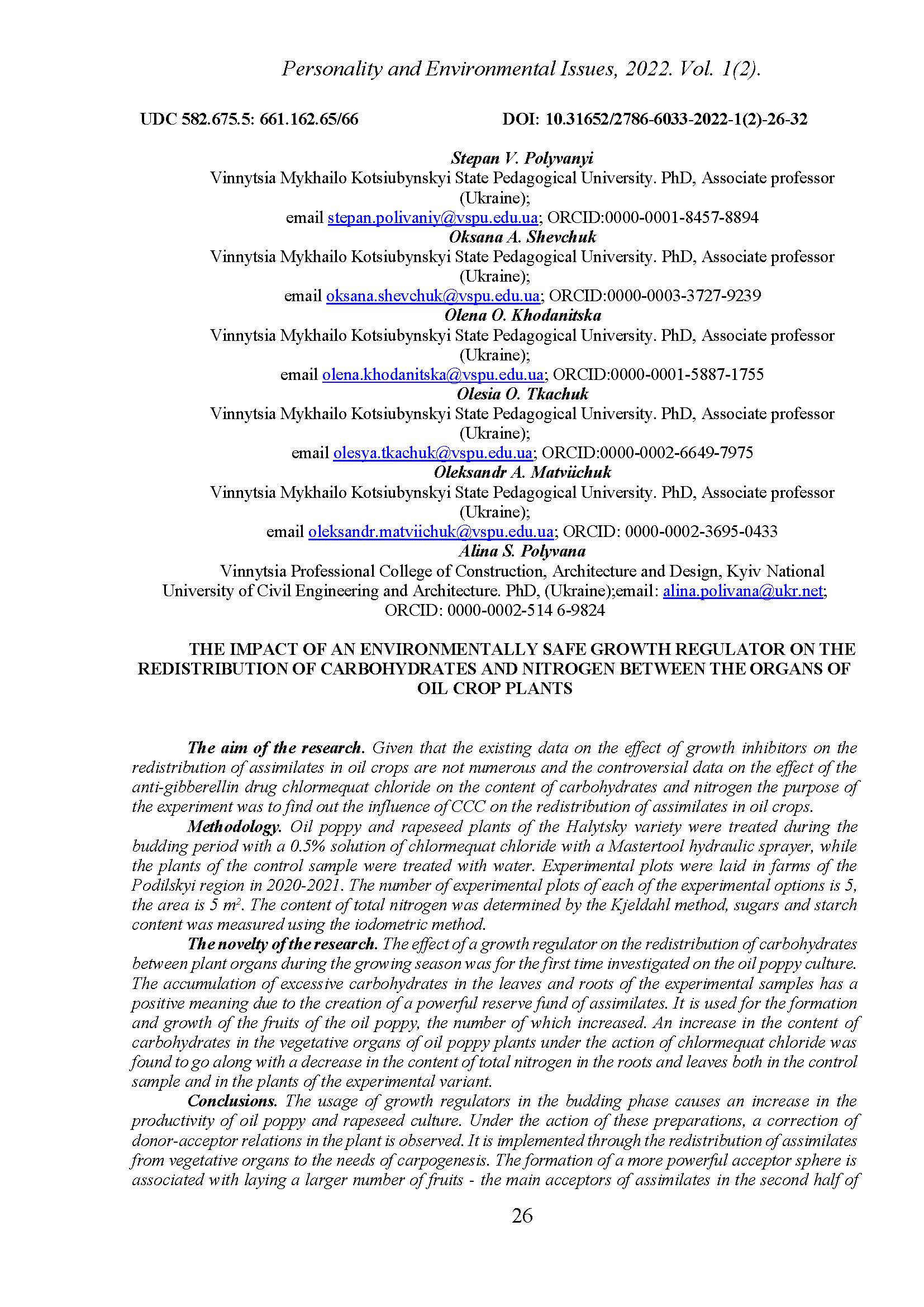Abstract
The aim of the research. Given that the existing data on the effect of growth inhibitors on the redistribution of assimilates in oil crops are not numerous and the controversial data on the effect of the anti-gibberellin drug chlormequat chloride on the content of carbohydrates and nitrogen the purpose of the experiment was to find out the influence of CCC on the redistribution of assimilates in oil crops.
Methodology. Oil poppy and rapeseed plants of the Halytsky variety were treated during the budding period with a 0.5% solution of chlormequat chloride with a Mastertool hydraulic sprayer, while the plants of the control sample were treated with water. Experimental plots were laid in farms of the Podilskyi region in 2020-2021. The number of experimental plots of each of the experimental options is 5, the area is 5 m2. The content of total nitrogen was determined by the Kjeldahl method, sugars and starch content was measured using the iodometric method.
The novelty of the research. The effect of a growth regulator on the redistribution of carbohydrates between plant organs during the growing season was for the first time investigated on the oil poppy culture. The accumulation of excessive carbohydrates in the leaves and roots of the experimental samples has a positive meaning due to the creation of a powerful reserve fund of assimilates. It is used for the formation and growth of the fruits of the oil poppy, the number of which increased. An increase in the content of carbohydrates in the vegetative organs of oil poppy plants under the action of chlormequat chloride was found to go along with a decrease in the content of total nitrogen in the roots and leaves both in the control sample and in the plants of the experimental variant.
Conclusions. The usage of growth regulators in the budding phase causes an increase in the productivity of oil poppy and rapeseed culture. Under the action of these preparations, a correction of donor-acceptor relations in the plant is observed. It is implemented through the redistribution of assimilates from vegetative organs to the needs of carpogenesis. The formation of a more powerful acceptor sphere is associated with laying a larger number of fruits - the main acceptors of assimilates in the second half of the growing season. An increase in the load of the plant with fruits in the plants of the experimental variants also affected a more intensive flow of carbohydrates and nitrogen-containing compounds to them, which ultimately led to an increase in the seed yield.
References
AOAC (2010). Official Meethods of Analysis of Association of Analytical Chemist International 18th ed. Rev. 3. 2010. Asso of Analytical Chemist. Gaithersburg, Maryland, USA.
Kumar, S., Sreenivas, G., Satyanarayana, J., & Guha, A. (2012). Paclobutrazol treatment as a potential strategy for higher seed and oil yield in field-grown Camelina sativa L. Crantz. BSK Research Notes 5(1), 1-13. doi: 10.1186/1756-0500-5-137
Kuriata V.G., Rohach V.V., Rohach T.I., Khranovska T.V. 2016. The use of antigibberelins with different mechanisms of action on morphogenesis and production process regulation in the plant Solanum melongena (Solanaceae). Visnyk of Dnipropetrovsk University. Biology, Ecology. 24(1), 230-233
Kuryata, V. G., & Khodanitska, O. O. 2018. Features of anatomical structure, formation and functioning of leaf apparatus and productivity of linseed under chlormequatchloride treatment. Ukrainian Journal of Ecology, 8(1), 918-926.
Kuryata, V.G., Polyvanyi, S.V. 2018. Features of morphogenesis, donor-acceptor system formation and efficiency of crop production under chlormequat chloride treatment on poppy oil. Ukrainian Journal of Ecology, 8(4), 165-174.
Kuryata,V. G. 2009. Retardants - modifiers of hormonal status of plants/ Plant Physiology: problems and prospects.Part 1. Logos , Kyiv
Liu, Y., Fang, Y., Huang, M., Jin, Y., Sun, J., Tao, X., Zhang, G., He, K., Zhao, Y.,& Zhao, H. (2014). Uniconazole-induced starch accumulation in the bioenergy crop duckweed (Landoltia punctata) II: transcriptome alterations of pathways involved in carbohydrate metabolism and endogenous hormone crosstalk. Biotechnologie for Biofuels, 8:64. DOI 10.1186/s13068-015-0245-8
Matysiak, K., Kaczmarek, S. 2013. Effect of chlorocholine chloride and triazoles – tebuconazole and flusilazole on winter oilseed rape (Brassica napus var. oleifera L.) in response to the application term and sowing density. J. Plant Prot. Res., 53(1), 79–88. doi: 10.2478/jppr-2013-0012.
Mohammad, N. K., & Mohammad, F. (2013). Effect of GA3, N and P ameliorate growth, seed and fibre yield by enhancing photosynthetic capacity and carbonic anhydrase activity of linseed. Integrative Agriculture 12(7), 1183-1194. doi: http://dx.doi.org/10.1016/S2095-3119(13)60443-8
Pageau D. Effet du taux de semis et de la fertilization azotee sur la productivite du lin oleagineux / D. Pageau, J. Lajeunesse, J. Lafond // Can. J. Plant. Sci. – 2006. – 86. – № 2. – С. 363-370.
Polyvanyi S.V., Golunova L.A., Baiurko N.V., Khodanitska O.O., Shevchuk V.V.,. Rоgаch Т.І, Tkachuk O.O., Shevchuk O.A. 2020. Morphogenesis of mustard white under the action of the antigibberellic preparation chlormequat chloride. Modern Phytomorphology. 14, 101-103 doi: 10.5281/zenodo.5077891
Shevchuk, O.A., Khodanitska, O.O., Tkachuk, O.O., Matviichuk, O.A., Polyvanyi. at all. 2021. Features of seed productivity of sugar beet plants under the influence of retardants. Ukrainian Journal of Ecology, 11(1), 143-148. doi: https://doi.org/10.15421/2021_21
Tkachuk O. O. Vplyv paklobutrazolu na vmist vuhlevodiv u roslynakh kartopli. Naukovi zapysky Ternopilskoho natsionalnoho pedahohichnoho universytetu imeni Volodymyra Hnatiuka. Seriia: Biolohiia. – 2015. – №1. – S. 144-147.
Yan, W., Yanhong, Y., Wenyu, Y., Taiwen, Y., Weiguo, L., &Wang X. (2013). Responses of root growth and nitrogen transfer metabolism to uniconazole, a growth retardant, during the seedling stage of soybean under relay strip. Communications in Soil Science and Plant Analysis Intercropping System. 44(22), 3267-3280. doi: http://dx.doi.org/10.1080/00103624.2013.840838

This work is licensed under a Creative Commons Attribution 4.0 International License.
Copyright (c) 2022 Stepan Polyvany, Oksana Shevchuk, Olena Khodanitska, Olesia Tkachuk, Oleksandr Matviichuk, Alina Polyvana





